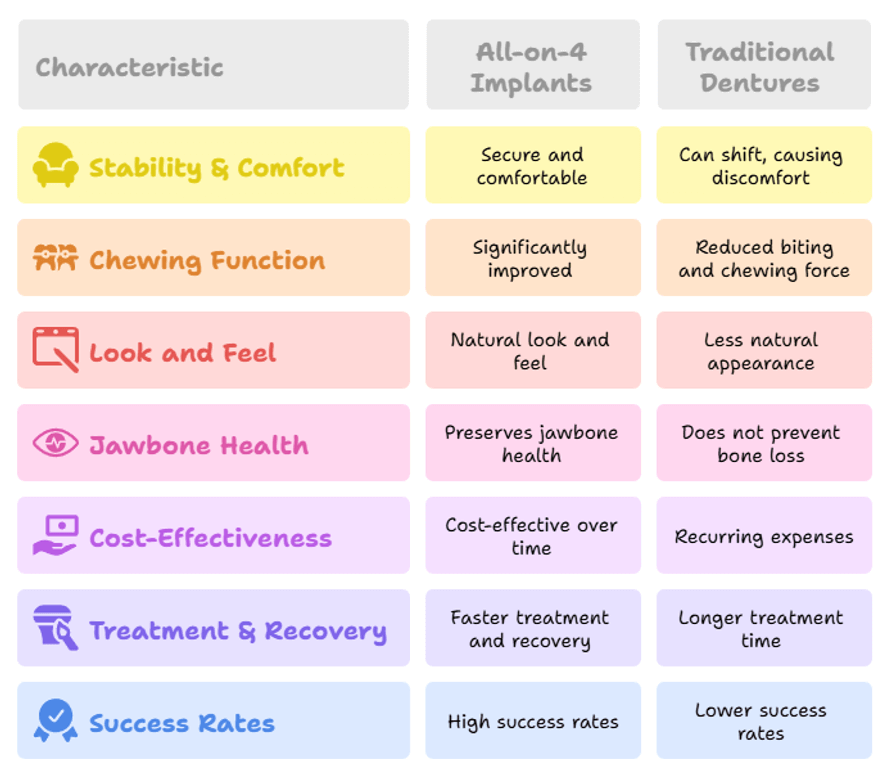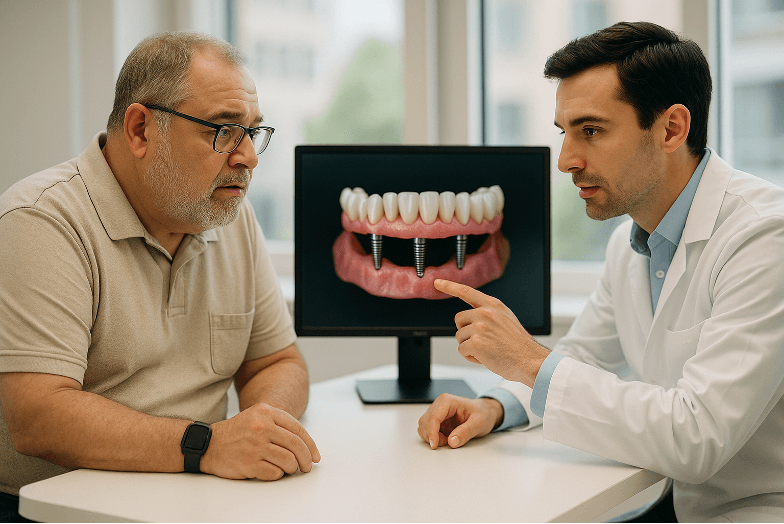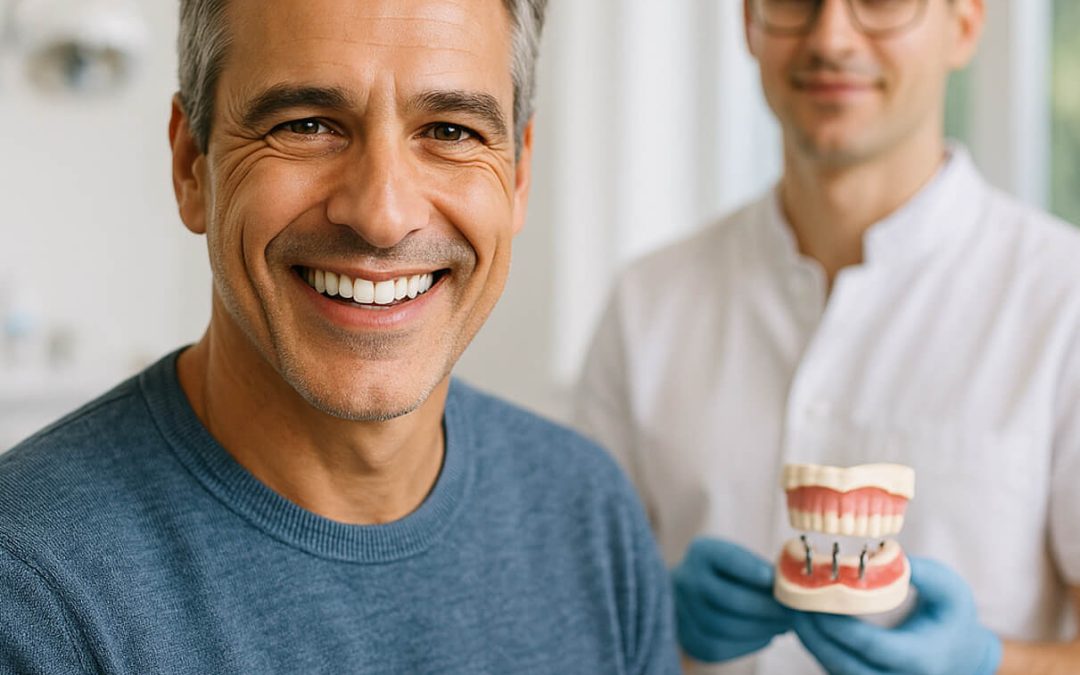Losing teeth can significantly impact your quality of life, affecting everything from your ability to eat and speak comfortably to your confidence when smiling. While traditional dentures offer a solution, many people seek a more stable, permanent alternative. This is where All-on-4 dental implants come in – offering a revolutionary way to restore a full arch of teeth using just four strategically placed implants.
If you’re looking for a dentist in Markham and considering options for full arch tooth replacement, understanding the All-on-4 concept is key to making an informed decision about your smile and oral health.
What are All-on-4 Dental Implants?
All-on-4 is a specific prosthodontics procedure designed for total rehabilitation of edentulous (toothless) patients, or those with severely compromised teeth needing full extraction.
The concept, pioneered by Nobel Biocare, involves replacing an entire arch of missing teeth with a fixed bridge that is securely attached to only four dental implants placed in the jawbone.
Unlike traditional dentures that rest on the gums and can slip or require adhesives, All-on-4 implants provide a stable, permanent foundation for your new teeth.
It’s a fixed solution that looks, feels, and functions much closer to natural teeth.
How the All-on-4 Technique Works?
The innovative aspect of the All-on-4 technique lies in the placement of the four implants.
While two implants are placed vertically in the anterior part of the jaw, the two posterior implants are strategically angled (up to 45 degrees).
This angulation allows the implants to utilize denser bone in the front of the jaw and often avoids the need for bone grafting procedures, even in cases of some bone loss.
Once the four implants are securely placed, a provisional (temporary) bridge is typically attached on the same day – a concept often referred to as “Teeth in a Day.”
This allows patients to leave the clinic with a functional and aesthetic set of teeth while the implants heal and integrate with the bone.
After a healing period (osseointegration), a final, permanent custom-designed prosthesis is attached to the implants.
Key Benefits of Choosing All-on-4

All-on-4 dental implants offer numerous advantages for patients seeking a fixed, full-arch restoration:
- Improved Stability and Comfort: Because the prosthesis is anchored to implants in the bone, it doesn’t shift or move like traditional dentures, eliminating discomfort, soreness, and the need for adhesives.
- Enhanced Chewing Function: Enjoy a significantly improved biting and chewing force compared to dentures, allowing you to eat a wider variety of foods with confidence.
- Natural Look and Feel: The fixed prosthesis is custom-designed to match your facial structure and desired aesthetics, providing a natural-looking smile and feeling much like your own teeth.
- Preserves Jawbone Health: Implants stimulate the jawbone, helping to prevent the bone loss and facial sagging that often occur with missing teeth and traditional denture wear.
- Cost-Effectiveness Over Time: While the initial cost is higher than dentures, All-on-4 can be a more cost-effective long-term solution as it is permanent and avoids ongoing expenses like adhesives and frequent relining or replacement needed for dentures.
- Faster Treatment & Recovery: The angled implant technique often eliminates the need for extensive bone grafting, leading to a less invasive procedure and a shorter overall treatment time compared to placing a higher number of traditional implants.
- High Success Rates: All-on-4 procedures have a high success rate. Reported patient success rates are around 94% after ten years, with prosthesis survival rates around 98.8% after 18 years with proper care.
Are You a Candidate for All-on-4 Implants?
All-on-4 is an excellent option for many individuals who are missing most or all of their teeth in an arch or who have failing teeth that require extraction.
General candidacy criteria include:
- Being in good general health.
- Having sufficient bone density, particularly in the anterior jaw, to support the four implants.
- Being free from active periodontal disease.
- Being committed to maintaining good oral hygiene.
While bone density is crucial, the All-on-4 technique is often suitable even for patients with some bone loss who might not be candidates for traditional implants needing more implants or grafting.
All-on-4 for Diabetics: Addressing Specific Concerns
Patients with diabetes often have concerns about implant candidacy and healing. While diabetes can increase the risk of complications, well-controlled diabetes is generally not a contraindication for dental implants, including All-on-4.

Successful outcomes depend on:
- Maintaining excellent blood sugar control before, during, and after the procedure.
- Having a thorough medical evaluation by your doctor.
- Following all post-operative care instructions diligently.
- Choosing an experienced dental team familiar with treating diabetic patients.
Your dental professional will conduct a comprehensive evaluation, including reviewing your medical history and performing imaging (like X-rays or CT scans) to determine if All-on-4 is the right solution for your specific situation.
The All-on-4 Procedure: Step-by-Step Guide
Understanding the process can help ease any anxiety. The All-on-4 procedure typically involves several stages:
- Initial Consultation & Planning: This begins with a thorough examination, review of your medical history, and advanced imaging (such as 3D cone-beam CT scans). Your dental team will assess your oral health, bone structure, and discuss your goals to create a personalized treatment plan.
- Day of Surgery: On the day of the procedure, any remaining failing teeth in the arch will be extracted. The four dental implants are then surgically placed into the jawbone according to the treatment plan. Local anesthesia and often sedation are used to ensure your comfort during the procedure.
- Receiving the Provisional Prosthesis: In many cases, a temporary, provisional bridge is attached to the newly placed implants immediately after surgery. This allows you to leave the clinic with a full set of functional teeth, enabling you to speak and eat soft foods while your implants heal.
- The Healing Period (Osseointegration): A crucial phase where the implants integrate with the surrounding bone. This process, called osseointegration, typically takes several months. During this time, you’ll wear the provisional prosthesis and follow dietary guidelines.
- Placement of the Final, Permanent Prosthesis: Once the implants have fully healed and fused with the bone, the provisional bridge is replaced with your custom-designed, permanent prosthesis. This final bridge is crafted from durable, aesthetic materials and is designed to provide optimal function, comfort, and appearance for the long term.
Recovering from All-on-4 Surgery
Recovery is a critical part of the All-on-4 process. While recovery is often faster and less complex than procedures requiring extensive grafting, proper care is essential:
- Immediate Post-Operative Care: Expect some swelling, bruising, and discomfort in the days following surgery. Pain medication will be prescribed to manage this. Applying ice packs can also help reduce swelling.
- Dietary Guidelines: A soft food diet is necessary initially to avoid putting excessive pressure on the healing implants. Your dental team will provide specific instructions on when and how to gradually reintroduce firmer foods as healing progresses.
- Oral Hygiene During Healing: Gentle cleaning is important. You’ll receive specific instructions on how to keep the surgical sites and the provisional prosthesis clean without disturbing the healing tissues.
- Follow-up Appointments: Attending all scheduled follow-up appointments is vital for your dental team to monitor your healing progress and the integration of the implants.
Most patients can return to normal activities within a few days, although a soft diet may be required for several weeks or months.
Potential Problems and How They Are Managed
Like any surgical procedure, All-on-4 carries potential risks, though complications are rare with an experienced team.
Addressing these potential issues upfront is part of providing comprehensive care. Potential problems can include:
- Implant Failure: While success rates are high, implants can fail to integrate with the bone due to factors like infection, poor healing, or excessive force during the healing phase.
- Infection: Infection at the implant site is a risk, particularly with poor oral hygiene or in patients with uncontrolled systemic conditions.
- Bone Loss: Peri-implantitis, a form of gum disease around implants, can lead to bone loss if not managed.
- Prosthesis Issues: The provisional or final prosthesis can sometimes chip, fracture, or become loose.
- Bite Problems: Improper bite alignment can cause discomfort or place excessive strain on the implants or prosthesis.
- Nerve Damage or Sinus Issues: Though rare, incorrect implant placement can potentially affect nearby nerves (causing numbness) or the sinus cavity (in the upper jaw).
Choosing a skilled and experienced dental surgeon significantly minimizes these risks. Should problems arise, prompt intervention is crucial.
Your dental team will monitor for signs of issues during follow-up appointments and guide you on recognizing potential symptoms yourself.
Maintaining excellent oral hygiene and attending regular check-ups are your best defense against complications.
The Cost of All-on-4 Dental Implants
The cost of All-on-4 dental implants is a significant consideration. It’s an investment in your health and quality of life, and the price can vary based on several factors:
- Location: Costs differ significantly depending on the region and even the specific clinic.
- Clinic Expertise: The experience and specialization of the dental team performing the procedure can influence cost.
- Materials Used: The materials used for the final prosthesis (e.g., acrylic, porcelain, zirconia) affect the overall price.
- Additional Procedures: The need for extractions, or other preliminary treatments, will add to the total cost.
- Upper vs. Lower Arch: The upper arch procedure can sometimes be more complex due to proximity to the sinus cavity.
In Canada, typical ranges for All-on-4 per arch can be anywhere from $20,000 to over $30,000 CAD or more, depending on the factors above.
It’s essential to get a detailed quote during your consultation that outlines all anticipated costs.
While dental tourism offers cheaper options in some countries, many patients prefer receiving care locally where follow-up and long-term maintenance are easily accessible.
Financing options and payment plans are often available to help make the treatment more manageable. Discuss these options with your dental clinic’s administrative team.
Living with All-on-4: Long-Term Care and Maintenance
Proper care is vital for the long-term success and longevity of your All-on-4 implants and prosthesis.
- Daily Oral Hygiene: Unlike dentures, you don’t remove your All-on-4 prosthesis for cleaning. You’ll need to clean around and under the bridge daily using specialized tools like water flossers, interdental brushes, and floss threaders to remove food particles and plaque from beneath the bridge and around the implants. Brushing the surface of the bridge is also necessary.
- Regular Dental Check-ups and Professional Cleanings: These are non-negotiable. Your dental team will perform thorough cleanings around your implants and prosthesis, check for any signs of issues like inflammation or bone loss, and ensure the prosthesis remains secure and in good condition. These appointments allow early detection and management of potential problems.
With diligent home care and regular professional maintenance, your All-on-4 implants can last for decades, and the prosthesis can provide many years of stable, comfortable function.
Conclusion
All-on-4 dental implants offer a transformative solution for individuals seeking a stable, fixed alternative to traditional dentures for full-arch tooth replacement. By anchoring a full set of prosthetic teeth onto just four implants, this technique provides significant improvements in function, comfort, aesthetics, and long-term oral health. Choosing All-on-4 is a significant investment in your smile and your quality of life. While it requires surgery and diligent ongoing care, the benefits for the right candidate can be immense, restoring your ability to eat, speak, and smile with confidence.
If you’re exploring your options for replacing missing teeth and are considering All-on-4 dental implants in Markham, the best next step is to consult with an experienced dental professional. They can evaluate your specific needs, discuss whether you are a suitable candidate, explain the process in detail, and help you determine the most appropriate treatment plan for your smile journey.
Bur Oak Dental offers free consultations for new patients. We invite you to visit one of our three convenient Markham locations to discuss your tooth replacement options, including All-on-4, in a comfortable and welcoming environment.
- Bur Oak Dental West: 20 Bur Oak Ave. Suite #1, Markham, ON L6C 0A2
- Bur Oak Dental Central: 549 Bur Oak Ave. Unit #3, Markham, ON L6C 3E5
- Bur Oak Dental East: 50 Anderson Ave. Unit #8, Markham, ON L6E 1A6
Let us help you regain your confident smile.
Frequently Asked Questions (FAQ)
Here are answers to some common questions about All-on-4 dental implants:
How long do All-on-4 implants last?
The implants themselves can potentially last a lifetime with proper care. The fixed prosthesis attached to the implants typically lasts between 10 to 15 years or more, depending on the materials used and how well it’s maintained, and may eventually need repair or replacement.
Can I eat normally with All-on-4?
After the initial healing period and once the permanent prosthesis is placed, you can typically eat most foods you enjoyed before, unlike with traditional dentures. You should still avoid extremely hard items like biting directly into nuts or hard candy to prevent damaging the prosthesis.
What are the signs of All-on-4 failure?
Signs can include pain, swelling, redness, or pus around the implant site, implant mobility, or the prosthesis becoming loose. If you experience any concerning symptoms, contact your dental professional immediately.
Is All-on-4 painful?
The procedure itself is performed under anesthesia or sedation, so you won’t feel pain during the surgery. Some discomfort, swelling, and bruising are normal during the initial recovery period, which can be managed with prescribed pain medication.
How do I clean my All-on-4 implants?
Cleaning requires specific techniques to access the area under the fixed bridge and around the implants. Your dental hygienist will instruct you on using tools like water flossers, interdental brushes, and specialized floss to keep the area clean and prevent plaque buildup.


